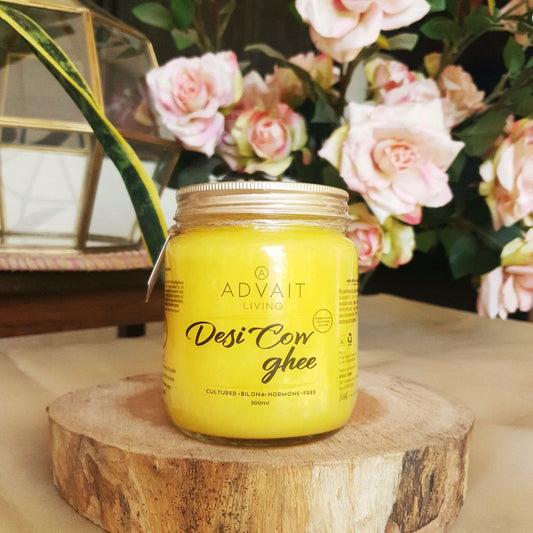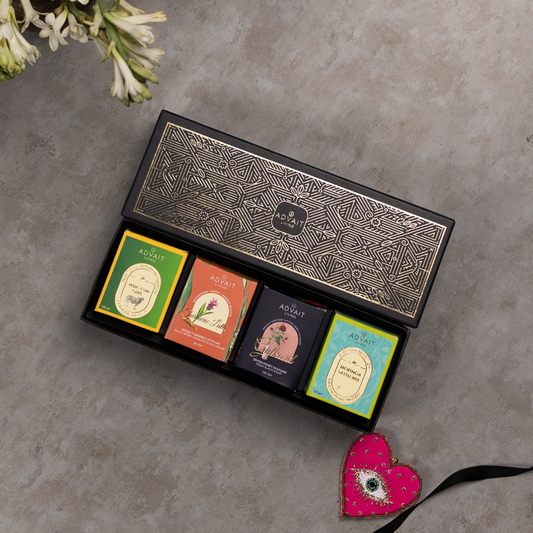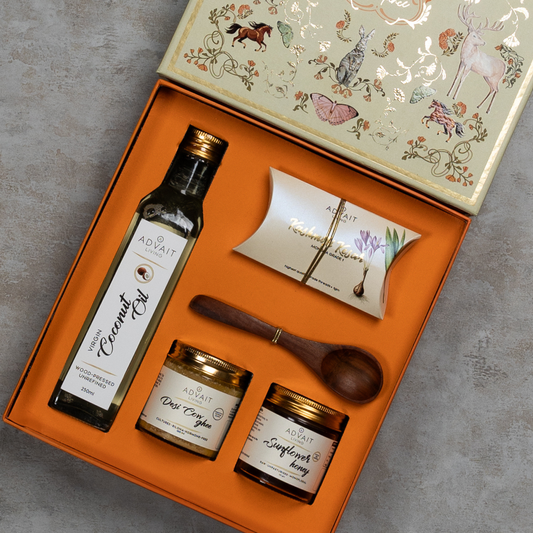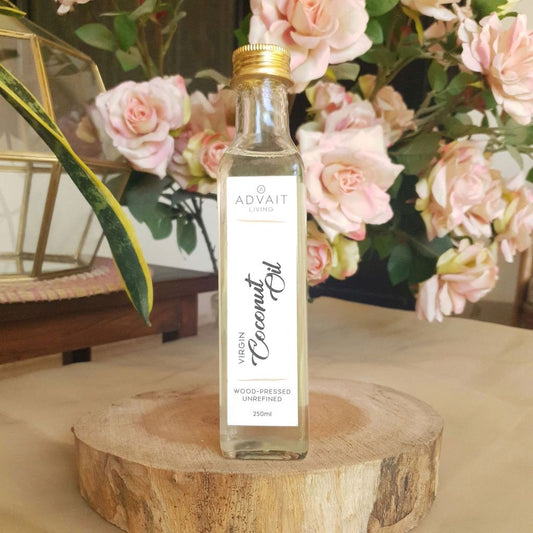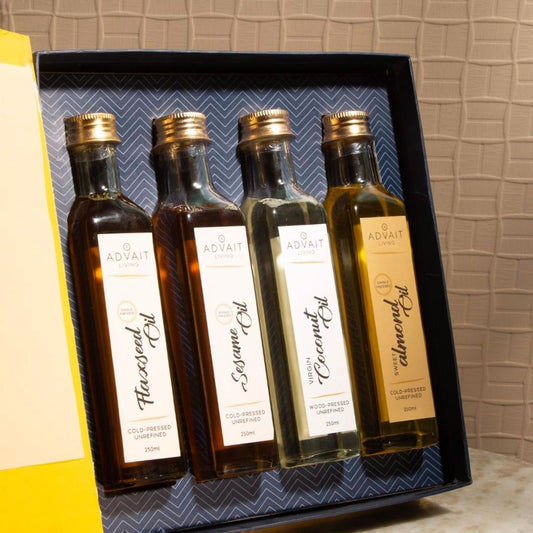In India, Ghee has been a culinary cornerstone and is found in almost all households. Revered for its rich aroma, flavour and excellent heat stability, ghee is the preferred cooking medium. Since ancient times, ghee has been considered highly beneficial and can be used in multiple ways to achieve optimal health. What sets ghee apart is its unique fat composition that offers superior health benefits surpassing nearly all other fats and cooking oils. Traditionally, ghee-making had been an intimate household craft. It was once a labour of love, handcrafted by moms and grandmothers, using traditional methods that had been handed down for generations. However, in more recent times, ghee-making moved to commercial setups that offered more convenience and affordability to consumers.
With traditional bilona ghee making a comeback, a pressing question arises: Which type of ghee truly deserves a place in your healthy kitchen, and why should you care?
Understanding Different Types of Ghee

Ghee, once a cornerstone of Indian cuisine and culture, saw a decline in its significance over the past few decades. For many years, the scientific community largely misunderstood the health implications of saturated fats. Ghee, rich in saturated fats, was caught in the crossfire of these misconceptions.
The resurgence of ghee in India is driven by a better understanding of the role that good saturated fats play in curbing inflammation and supporting the immune system and cardiac health. With the resurgence of the popularity of ghee, it is even more essential to understand which ghee to make part of our households. Interestingly, not all ghee are the same! Yes, actually there are various types of ghee available in the market, and knowing what makes a ghee can help you make an informed decision.
Ghee can be of many types and these can get very confusing:
- Cow Ghee
- Buffalo Ghee
- Mixed Ghee
- Clarified Butter
- A2 Ghee
- Grass-Fed Ghee
- Cultured Ghee
- Bilona Ghee
- Processed/Commercial Ghee
- Vedic Ghee
- Brahmi Ghee
- Vanaspati Ghee
Each ghee may differ depending upon several factors - the source of milk, cattle-rearing practices, type of milk, other added ingredients, and the process of how the ghee was made, additives & preservatives and so on. Some of the ghee may overlap with minor differences depending on the manufacturing processes.
However, today, we will try to demystify two major ghee types that are quite different from each other on several fronts - ‘Bilona Ghee and Commercial Ghee’.
What is Bilona Ghee?

‘Bilona Ghee’ refers to a traditional, labour-intensive method of making ghee. The distinct properties of bilona ghee stem from the meticulous process used in its preparation that is prescribed in Ayurveda and celebrated in mythology, bestowing it with unique properties that even modern science is beginning to appreciate. In fact, ‘bilona’ refers to the wooden stick that is used to churn ‘curd’ (yoghurt) bi-directionally to separate ghee from butter. Traditionally, this is a slow process, usually done manually and uses the milk of native Indian cows that are traditionally grass-fed. Ghee made by the bilona process is called ‘bilona ghee’ and may also be referred to as ‘desi ghee’.
Bilona Ghee is a time-honoured traditional food that can be traced to some of the oldest scriptures in Hindu Mythology. Bilona ghee holds a very special place in Indian mythological, traditional medicinal and even cultural traditions. In Hindu mythology, ghee is often linked to creation and cosmic order. According to the Vedas, particularly the Rigveda, ghee was essential in the primordial sacrifice performed by the gods to create the universe. It is often referred to as 'amrit' the nectar for the gods with the power to bestow immortality! The Ramayana also illustrates the importance of ghee in religious and cultural practices. The great epic Mahabharat highlights Lord Krishna’s love for ghee and butter. And mentions ghee as an essential element in key rituals performed by the kings and sages.
Even Ayurvedic texts, which form an integral part of Indian mythology and traditional knowledge, extol the virtues of bilona ghee as a healer and sustainer. Ayurveda considers ghee a powerful substance with the ability to enhance ojas (vital energy), improve digestion, and act as a carrier for medicinal herbs.
What is Commercial Ghee?

Commercial ghee refers to ghee produced on an industrial scale in modern dairy plants, often through processes that differ significantly from traditional methods. This type of ghee is widely available in markets and is typically designed to cater to the large-scale demands of modern consumers, offering convenience and affordability. Commercial ghee may also be colloquially termed as ‘processed ghee’ or ‘industrial ghee’ or even ‘normal ghee’.
The industrialisation of ghee production in India is a significant development in the country’s dairy sector, transforming ghee from a household staple produced through traditional methods to a widely available commercial product. The most significant push towards the industrialisation of dairy products, including ghee, came with the ‘White Revolution’ in the 1970s, led by the National Dairy Development Board (NDDB).
Operation Flood aimed to create a nationwide milk grid, increasing milk production and making dairy products more accessible, thereby improving the small farmer's income as well. Moreover, the establishment of dairy cooperatives played a crucial role in industrialising ghee production. The cooperatives collected milk from numerous small farmers and processed it in centralised facilities, ensuring a consistent and high-quality supply of dairy products, including ghee.
‘Commercial’ or ‘mass-produced’ ghee is typically made from cream or milk powder, using processes that are mechanised and rapid and use large automated equipment to process large amounts of ghee at a given time. Modern dairy plants utilise advanced technologies for milk collection, cream separation, butter making, and ghee separation. Manufacturers may also deploy various processing methods to increase shelf stability and reduce costs. One of the most favourable features of commercial ghee is the price affordability for its potential consumers. Commercial ghee continues to play a vital role in making this traditional Indian staple accessible to a global audience.
Bilona vs Commercial Ghee: Which One Merits a Place in Your Kitchen?
The choice between Bilona and commercial ghee depends on individual preferences, priorities, and dietary needs. Several factors will influence your decision when choosing between ‘bilona ghee’ and ‘commercial ghee’ for your lifestyle and family. For those looking to integrate traditional wisdom, artisanal methods and higher nutritional value into their diet, Bilona ghee stands out. For everyday cooking, price affordability and broader accessibility, commercial ghee serves well. Here are key factors to evaluate the better choice for your household.
I. Quality of Milk

A good quality ‘Bilona ghee’ will use raw milk as the main ingredient for making ghee. As per Ayurveda, the best raw milk to use is from ‘grass-fed’ cows as it is more nutritiously endowed. Milk from Indigenous cow breeds native to India, such as Gir, Sahiwal, Rathi, Karkraj and Tharparkar are preferred for milk collection. Smaller farmers practise grass-feeding & pasture-grazing techniques as part of their traditional cattle-rearing practices, providing the cows with better feed including natural grass, forest herbs and medicinal plants, among others. The milk produced is naturally nutritious. Bilona ghee is a small-scale operation and this provides an easy opportunity to trace the origin of the milk and monitor the quality of the milk as well.
On the other hand, it is difficult to trace the milk origins used to make commercial ghee. Due to its large-scale operations, commercial ghee collects milk from farmers which can be from mixed cattle - such as buffalo, cows, goats and sometimes even camel milk. Commercial ghee mostly uses buffalo milk (as it is one of the largest livestock held by farmers due to its high-yielding milk capacity) followed by milk from hybrid cow breeds such as Holstein, Friesian, Ayrshire, and British Shorthorn.
Farmers from certain regions may largely provide goat and camel milk as well. Moreover, while smaller farmers practise grass-feeding & pasture-grazing techniques; large dairy farms may practise feeding grains and corn to their cattle, which may affect the quality of milk. Tracing the origins of milk used in commercial ghee is typically very hard and expensive and as such, it is difficult to monitor the quality of milk as well.
II. A1 vs A2 Protein

In recent years, A2 milk and ghee have gained significant popularity. But what exactly is A2 and how does it make it better? A2 is a protein found in a select few cattle, and more so in native breeds of cows such as gir, tharparkar, rathi, sahiwal among others. Milk of European breeds such as Jersey cows, Holstein cows, etc does not have the A2 protein, rather it contains another variant - A1 beta-casein protein. In some research, A1 protein is linked to type 1 diabetes, digestive problems including lactose intolerance, autism, and when digested may be especially harmful for children. Consuming A2 ghee can be easier on the stomach and quick to digest.
III. Production Method

One of the most significant differences between Bilona ghee and commercial ghee is the production process.
1. Curd Vs Cream: The key differentiator is the starting point for making ghee in both processes. Bilona ghee converts raw milk to curd as the foundational step to making ghee. In the Bilona process, nearly 25-27 litres of cow milk is first converted to curd, which in turn is further processed to make 1 litre of bilona cow ghee.
Generally, commercial production of ghee differs from the bilona process and skips the steps of converting milk to curd. Instead, it starts with ‘cream’. This method involves the separation of cream from the milk to prepare the ghee. Four different ghee-making methods, such as the direct cream method, creamery butter method, pre-stratification method, and continuous method are used for factory-made ghee production.
2. Fermentation of Milk: In the making of bilona ghee, fresh whole milk is boiled and fermented overnight to make curd. During the fermentation process, the bacteria converts lactose molecules in the milk to lactic acid which are much smaller molecules and far more easier to digest. This makes the milk and subsequently, the ghee lactose-free, making it easier for children and older adults to consume. Furthermore, the fermentation process also produces gut-friendly bacteria (probiotics) in the curd which enhances the nutritional profile and contributes to the rich flavour and aroma of the bilona ghee.
Conversely, commercial ghee uses fresh milk and is processed through mechanical separators to extract cream. No fermentation takes place, and the butter is extracted by churning the cream using a butter churner. This industrial process loses probiotics and lacks the unique flavour and aroma of traditional ghee.
3. Artisanal Vs Mechanised: The Bilona ghee process is slow, labour-intensive and skill-oriented and the entire process takes more time to complete. Due to this, usually, this ghee is produced in small batches.
The process includes the following steps -
- Raw milk is collected and boiled to remove any undesired bacteria.
- A starter culture of 'dahi' (curd) is added to the milk and left till the curd is set (this can take more than one day).
- Once the raw milk is converted to curd, traditional bilona (bi-directional) churning of curd separates good fat (butter) from buttermilk.
- Butter is slow-cooked on low flame and by direct open pan heating to get delicious granular ghee.
On the other hand, the cornerstone of processed ghee is its ability to use advanced equipment to rapidly convert cream into ghee in large volumes to make it cost-effective. Commercial ghee uses fresh milk and is processed through mechanical separators to extract cream.
- Milk is filtered and stored in raw milk silos in which the temperature of the milk is not beyond 5℃. Full cream milk is pasteurised at 90±2℃, cooled down, and passed to a homogeniser to obtain uniform globule size. After storing the milk in a balance tank, the cream is extracted using a cream separator. This whole process takes around 5 to 6 hours.
- After collecting the cream, it is fed into the butter churner, and the butter is churned from the cream. Later, it is washed with cold water to separate the butter from the buttermilk.
- The butter obtained in the previous step is put into a melted vat and melted at 65℃ for the next 10 to 15 minutes. Once the butter is melted, it will start to foam, followed by evaporation, and finally, begin to splutter. After melting the butter, it is transferred to a settling tank and left undisturbed to allow the layers to separate.
- Melted butter is further boiled in a ghee kettle at a temperature from 107℃ to 109℃. The ghee and other solid remains settle unstirred for about 15 to 20 minutes and move to settling vats for 2 hours.
- Finally, the ghee obtained is filtered using a ghee clarifier at approximately 70℃ and stored for filling and packing after ghee inspection and testing.
4. Hydrogenation of Ghee:
It's important to note that some industrialised ghee is actually hydrogenated vegetable oils that mimic the appearance, texture and smell of the original ghee. Such ghee is also called vegetable ghee, and may be known as vanaspati ghee as well. Unlike traditional ghee, which is made from animal milk fats, vegetable ghee is entirely plant-based (and is not really ghee).
To make this product, vegetable oils are heated in the presence of a catalyst (usually nickel) and hydrogen gas that converts unsaturated fats (liquid at room temperature) into saturated fats (solid at room temperature). The vegetable oils are further processed to alter the chemical structure, making the oil more stable and giving it a texture similar to traditional ghee. Artificial flavours and colours are often added to mimic the taste and appearance of traditional ghee. Beta-carotene is a common colouring agent used to give vegetable ghee a yellowish hue.
IV. Appearance, Taste, Aroma and Flavour

Bilona ghee is known for its distinctive golden-yellow colour and rich, nutty aroma. It has a granular texture that is smooth and slightly grainy, which sets it apart from other types of ghee. Bilona ghee is also known for its rich aroma and its ability to enhance flavour of the dishes. Each batch of bilona ghee will differ in terms of appearance and aroma. These depend upon seasonal variation, ambient temperature and the variations in the cows' diet.
For example - in seasons when cows have access to fresh, green grass, the butter they produce is richer in beta-carotene, which imparts a more vibrant yellow colour to the ghee. And in seasons with less fresh forage, the butterfat may contain lower levels of beta-carotene, resulting in a paler ghee. Additionally, seasonal changes can affect the cows' overall health and milk production, further impacting the ghee's colour.
The bedrock of commercial ghee marketing is the standardisation of ghee to ensure consistent appearance, smell, taste, flavour, and quality. To achieve standardised ghee, manufacturers closely control factors like the introduction of cream, duration, temperatures, fat content, colour, texture, and aroma, making the product uniform and reliable for consumers. Standardisation also helps in meeting regulatory standards.
V. Shelf Life
Bilona ghee has a lower shelf-life as it is made from pure, unadulterated butter without additives or preservatives, making it more prone to spoilage. Furthermore, the traditional process might not eliminate moisture as efficiently as industrial methods, leading to faster degradation of bilona ghee.
Unlike bilona ghee, industrial methods employ rigorous quality control measures to ensure uniformity in fat content and processing that produces a stable product. The industrial process also ensures thorough removal of moisture and impurities, reducing the risk of microbial growth and spoilage. Moreover, processed ghee may contain additives, colouring agents, and preservatives like butyl hydroxy anisole to increase the shelf-life.
VI. Additives and Preservatives
A good quality Bilona ghee preparation doesn’t involve any addition of preservatives or additives, making it pure and authentic. Unlike bilona ghee, processed ghee may contain additives such as butylated hydroxyanisole (BHA) and butylated hydroxytoluene (BHT), which help prevent oxidation and rancidity. Some brands may add artificial colouring to maintain a consistent appearance and some may even add emulsifiers to improve texture and consistency.
VII. Nutritional Benefits
Bilona ghee is highly nutritious as it uses 25 litres of fermented milk (without the removal of any component at the start). Unlike processed ghee, Bilona ghee doesn’t undergo heavy processing preserving its nutritional content. This ghee is primarily composed of 99% of fat, 0.3% of protein, and 0.3% of water. It is predominantly composed of saturated fats like palmitic, stearic, and myristic acid. It also contains lower amounts of short-chain fatty acids such as butyric, caproic, caprylic, and capric acid. This provides a longer shelf-life for ghee with less rancid off-flavour.
Bilona ghee contains vitamins A, B, D, K, and E and amino acids like alanine, leucine, aspartic acid, serine, proline, valine, etc. Besides this, calcium and potassium are also present in the ghee. Ghee lacks carbohydrates, proteins, and fibre and contains only a trace amount of water. Ghee is also rich in conjugated linoleic acid (CLA) and has potential health benefits such as anticarcinogenic, antiatherogenic, antidiabetic, and anti-adipogenic properties. Another study also suggested that ghee has a higher amount of DHA (a type of Omega-3 fatty acid).
Conversely, industrial or processed ghee uses milk with little to zero traceability and hence has very little monitoring of the quality of milk or cattle feed, potentially compromising its nutritional value. Further, it only contains the nutrients available in cream to begin with. Heavy-duty processing, standardisation and addition of additives & preservatives lower the nutritional value of the ghee compared to bilona ghee. It also favours the speedy production of ghee and involves high-heat processing that diminishes the nutrients present. During processing, overheating of ghee may lead to the formation of hazardous chemical compounds like acrolein, formaldehyde, and polycyclic aromatic hydrocarbons (PAHs). Additionally, it may contain trans fat and hydrogenated oil that pose a risk to human health.
Why Choose Bilona Ghee over Commercial Ghee?

When it comes to incorporating ghee into your diet, choosing bilona ghee over processed ghee offers superior quality ghee and more health.
- Bilona ghee is produced from the milk of indigenous cow breeds known for superior milk quality. Milk origins can be traced and the quality of milk and cattle feed can be monitored to improve the quality of ghee.
- The Bilona process is highly recommended for its ability to produce high-quality ghee by Ayurveda, the quintessential book for natural and preventive healthcare that has been revered in India since ancient times.
- Bilona ghee offers a healthier alternative to commercial ghee. The milk is fermented naturally and churned using a wooden beater, preserving the nutrients of the ghee. With high-quality A2 grass-fed cow milk, bilona ghee is rich in fatty acids, vitamins, minerals, and antioxidants that contribute to overall health. The slow and gentle process of ghee production minimizes heat exposure and retains nutritional value.
- Bilona ghee not only preserves the goodness of milk but also delivers a rich aroma, taste, texture and flavour experience. It is known for its aromatic enhancement of food.
- Good quality Bilona ghee will be free of any additives and preservatives, making it safer for consumption.
- Bilona ghee is usually free of lactose, making it easier to digest.
- Bilona is a traditional process that is sustainable and eco-friendly requires minimal energy consumption and contributes to a lower carbon footprint than industrialised ghee.
If you are considering Bilona ghee and would like to know more about how to identify pure desi ghee, we highly recommend you read these guidelines before purchasing your ghee.
Health Benefits of Bilona Ghee

Bilona ghee not only adds distinct flavour and aroma to dishes but also provides various health benefits on consumption. Here are some of the health benefits that bilona ghee offers.
- Aids in Weight Loss: Regular consumption of ghee reduces body fat and aids with weight loss. Short-chain fatty acids (SCFA), especially butyric acid present in ghee, are easy to digest and transfer directly from the intestine to other parts of the system and act as a preferred source of energy (β-oxidation). It also stimulates the gastric secretion to help digestion. The medium-chain fatty acids release energy that burns fats and reduces weight.
- Aids in Detoxifying Toxins: Bilona ghee contains butyrate that effectively balances vata, pitta, and kapha and detoxifies toxins in the body. This process is called Snehana in Ayurveda and involves the consumption of ghee on an empty stomach each morning. After 20 minutes of consuming ghee, a glass of warm water is taken.
- Increases Energy Level: The presence of medium-chain fatty acids aids in the fast absorption of nutrients into the bloodstream and metabolises more efficiently than long-chain fatty acids. This increases the energy production in the body and increases metabolic rate.
- Supports Immune Function: Ayurveda highlights the importance of bilona ghee in immunomodulation. Ghee is considered “Rasayana” in Ayurveda and this word represents nourishing and distributing nutrients throughout the body. Ghee has been used for improving immune health for thousands of years and a ghee-based gold nanoparticle shows improved immune effects in children. Butyric acid in the ghee supports the production of killer T cells and strengthens the immune system. Additionally, the presence of omega-3 fatty acids has proven to manage allergic, inflammatory, and autoimmune diseases.
- Enhances Cardiovascular Health: Contrary to the common belief, ghee up to 10% level does not elevate the risk of cardiovascular diseases. Several components in the ghee help in reducing the formation of fatty streak and cholesterol levels. Also, an Ayurvedic ghee-based formulation, guggulutikthaka gritha (GTG) that treats dyslipidemia showed a significant decrease in serum lipids and blood glucose levels in rats. Another study conducted in Rajasthan found that men whose ghee intake is more than 1 kg/month had a much lower rate of coronary heart disease than men who consumed less amount of ghee.
- Improves Skin Health: Ghee and ghee-based formulations are widely used in the Ayurvedic treatment of several skin diseases. When infused with herbs, this ghee shows the effective ability to transport the key component of herbs to target tissue in the treatment of skin ailments. Besides this, the antioxidant, antiseptic, and antibacterial effects of ghee fight off skin diseases and improve skin condition. When it is blended with honey in alginate hydrogel, it repairs cutaneous wounds. The blend of ghee, honey, and Apamarga Kshara Yoga Lepa treats vitiligo, whereas, the blend of ghee, guduchi, and bhringraj powder treats eczema. It also moisturises skin, treats chapped lips and dark circles.
- Improves Bone Health: Panchatikta Ghrita, a ghee-based ayurvedic formulation with 5 herbs has shown anti-osteoporotic properties in rats. It showed better serum calcium and inorganic phosphate levels, reduced osteoclasts, and increased bone hardness. Another study also demonstrated the promising effects of this ghee in lowering the risks of postmenopausal osteoporosis. Massaging joints using ghee also relieves the pain associated with joints.
Other than the above-mentioned benefits, ghee can be used as carrier oil for botanical formulations and lubricate the joints and tissues to reduce inflammation and pain. Overall, bilona ghee has been used as a versatile ingredient in numerous Ayurvedic formulations.
Conclusion
When it comes to incorporating ghee into your diet, the choice between Bilona and commercial ghee depends on individual preferences, priorities, and dietary needs. For those looking to integrate traditional wisdom and higher nutritional value into their diet, Bilona ghee stands out. For those seeking convenience, affordability and ease of accessibility then commercial ghee is a practical choice.
Frequently Asked Questions
1. What is bilona ghee?
Bilona ghee is a traditional Indian clarified butter, made using an age-old method called the "bilona" process. This process starts with boiling raw, unpasteurised cow's milk and then allowing it to cool to room temperature. The cooled milk is then cultured with a small amount of curd, which turns it into yoghurt over several hours. The yoghurt is churned using a wooden beater, or "bilona," to separate the butter from the buttermilk. This butter is then collected and heated slowly until all the water evaporates, leaving behind pure ghee.
The bilona method is highly valued for preserving the nutrients and medicinal properties of the ghee. It is believed to be more nutritious and flavorful compared to commercially produced ghee. Rich in healthy fats and vitamins A, D, E, and K, bilona ghee is known for its potential health benefits, including improving digestion, boosting immunity, and enhancing skin health. Its traditional production process and use of high-quality cow's milk make bilona ghee a premium product, often associated with Ayurvedic practices and holistic wellness.
2. Why is Bilona ghee so expensive?
Bilona ghee is expensive due to its labour-intensive and time-consuming traditional production process. The entire process is done manually, requiring significant time and effort compared to industrial methods. In addition, bilona ghee requires a large quantity of milk. It takes about 25-28 litres of milk to produce just one litre of bilona ghee. This high milk-to-ghee ratio contributes to the cost, especially when using milk from grass-fed, free-range cows, which is often preferred for its higher quality and nutritional value.
Furthermore, bilona ghee is often associated with purity and adherence to traditional practices, appealing to consumers seeking premium, natural, and health-oriented products. Its production in smaller batches, attention to detail, and use of high-quality ingredients all add to the overall cost. The combination of these factors—manual labour, high milk requirements, and premium quality—makes bilona ghee more expensive than regular ghee.
3. What is the difference between A2 ghee and Bilona ghee?
While the term 'A2' refers to A2 protein found in milk, "Bilona' refers to the production process (and has nothing to do with the type of milk).
'A2 ghee' is ghee made from A2 milk. A2 is a protein found in some cattle milk, and is potentially healthier and easier to digest compared to its counter-part A1 protein that is also found in cattle milk. While making A2 ghee, it is ensured only milk with A2 protein is used for it to be called A2 ghee. It is important to note that 'A2 ghee' prepared from A2 milk, can be processed in various ways, including traditional bilona method and even from the industrialised techniques.
On the other hand, 'Bilona ghee', refers to a 'method' of making the ghee. Bilona ghee typically refers to the traditional method of ghee production that involves converting raw cow's milk into yoghurt, churning the yogurt bi-directionally ('bilona') to separate the butter, and then heating the butter slowly to prepare ghee. The bilona method is labour-intensive and preserves the ghee's nutrients and medicinal properties.
Both these concepts can intersect and you can get "A2 Bilona Ghee" which basically means that the ghee is made with A2 certified milk using the traditional ghee-making process. This combination ensures that the ghee not only has the potential health benefits of A2 protein but also the rich flavour and nutritional integrity preserved by the bilona method.
4. How do I know if my ghee is A1 or A2?
To determine if your ghee is A1 or A2, you need to know the type of milk used in its production. A1 and A2 refer to different types of beta-casein protein found in cattle milk. Here are steps to identify A1 or A2 ghee:
- Label Information: Check the packaging. Authentic A2 ghee will typically be labeled as such. It should explicitly state that it is made from A2 milk, and the label may even specify the breed of cattle such as Gir cows, Sahiwal cows, or Raathi cows, among others known for producing A2 milk.
- Certifications and Quality Assurance: Look for certifications. Brands will typically carry a A2 certification that certifies that the milk used for making the ghee has a the A2 protein.
- Brand Transparency: Research the brand. Reputable brands will provide detailed information about their sourcing and production processes. They may mention the specific breeds of cows and their commitment to using A2 milk.
- Contact the Manufacturer: If in doubt, contact the manufacturer directly. They should be able to provide details about the source of their milk and confirm whether it is A1 or A2.
- Price and Market Positioning: A2 ghee is often priced higher as A2 milk is rarer and produced in much lesser quantities, higher requirement of milk to make ghee (25-27 Ltrs of cow milk make 1 litre of ghee), and cattle rearing practices. If the ghee is significantly cheaper, it might be made from A1 milk.
By carefully examining these factors, you can determine whether your ghee is A1 or A2.
5. Which type of ghee is best?
The "best" type of ghee depends on individual health needs, dietary preferences, and the specific qualities you value in ghee. Here are key considerations:
- A2 Ghee: Made from the milk of cows that produce A2 beta-casein protein, A2 ghee is often preferred for its easier digestibility and potential health benefits. It is particularly suitable for individuals sensitive to A1 protein.
- Bilona Ghee: Produced using the traditional bilona method, this ghee retains more nutrients and medicinal properties. It's valued for its rich flavour and purity. If you prioritise traditional, artisanal production, bilona ghee is an excellent choice.
- Grass-Fed Ghee: Made from the milk of cows that graze on natural pastures, this type of ghee is rich in omega-3 fatty acids, vitamins, and antioxidants. It’s a good option for those looking for nutrient-dense ghee.
- Organic Ghee: Produced from the milk of organically raised cows, organic ghee ensures that no synthetic hormones, pesticides, or antibiotics are used. It's ideal for those committed to organic food.
Overall, a high-quality A2 Bilona ghee, like Advait Living's Ghee combining the benefits of A2 milk and traditional bilona production, is often considered the best for its digestibility, nutritional profile, and authentic preparation. However, the best choice ultimately depends on your health goals, dietary needs, and taste preferences.







